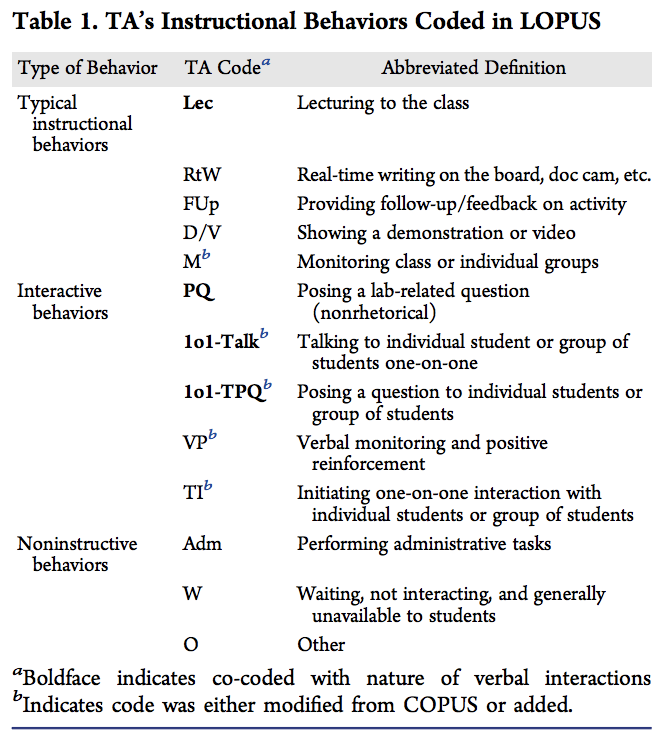Developed by Jonathan B. Velasco, Adam Knedeisen, Dihua Xue, Trisha L. Vickrey, Marytza Abebe, and Marilyne Stains
| Purpose | To categorize TAs’ instructional behaviors, student behaviors and verbal interactions between TAs and students in laboratory courses. |
|---|---|
| Format | Observation protocol |
| Duration | N/A min |
| Focus | Teaching (TA’s instructional behaviors, student behaviors, nature of verbal interactions between TA and students) |
| Level | Graduate, Upper-level, Intermediate, Intro college, High school, Middle school, Other |
The following are some example categories in LOPUS from Velasco et al 2016.

more details
This is the second highest level of research validation, corresponding to at least 5 of the validation categories below.
Research Validation Summary
Based on Research Into:
- Classroom behavior
Studied Using:
- Iterative observations
- Inter-rater reliability
- Training materials
Research Conducted:
- At multiple institutions
- By multiple research groups
- Peer-reviewed publication
LOPUS was based on the COPUS observation protocol, but was further developed based on literature on laboratory practices, and observations of lab classrooms. Researchers wanted a tool that captured: "(1) instructional behaviors without a priori assumptions about criteria for quality teaching, (2) the behaviors of TAs and students, (3) verbal interactions between TAs and students, and (4) the nature of the content being discussed during these verbal interactions." Fifteen graduate and undergraduate teaching assistants were observed to develop the tool. The researchers calculated inter-rater reliability. Researchers derived descriptive statistics of the proportion of behaviors, calculated as percentages of 2 min intervals in a video during which individual behaviors were observed, and the proportion of codes describing the nature of verbal interactions. Hierarchical cluster analyses were also conducted in order to characterize commonalities in TAs’ instructional styles and nature of verbal interactions. (Velasco et al. 2016)
References
- C. Doty, A. Geraets, T. Wan, E. Saitta, and J. Chini, Student perspective of GTA strategies to reduce feelings of anxiousness with cold-calling, presented at the Physics Education Research Conference 2019, Provo, UT, 2019.
- C. Doty, T. Wan, A. Geraets, C. Nix, E. Saitta, and J. Chini, Impact of changing physical learning space on GTA and student behaviors, presented at the Physics Education Research Conference 2020, Virtual Conference, 2020.
- D. Esparza, A. Wagler, and J. Olimpo, Characterization of Instructor and Student Behaviors in CURE and Non-CURE Learning Environments: Impacts on Student Motivation, Science Identity Development, and Perceptions of the Laboratory Experience, CBE Life. Sci. Educ. 19 (2), 18 (2020).
- A. Nguyen, X. Antoine-Goeas, M. Sulman, L. Tra, C. Cox, and O. Gulacar, A Qualitative Investigation of the Interactions of Students with Graduate and Undergraduate TAs in General Chemistry Laboratories, Educ. Sci. 11 (10), 655 (2021).
- J. Velasco, A. Knedeisen, D. Xue, T. Vickrey, M. Abebe, and M. Stains, Characterizing Instructional Practices in the Laboratory: The Laboratory Observation Protocol for Undergraduate STEM, J. Chem. Educ. 93 (7), 1191 (2016).
- T. Wan, C. Doty, J. Chini, A. Garaets, and E. Saitta, Characterizing science graduate teaching assistants’ instructional practices in reformed laboratories and tutorials, Int. J. STEM Educ. 7 (1), 30 (2020).
- T. Wan, C. Doty, A. Geraets, E. Saitta, and J. Chini, Characterizing graduate teaching assistants’ teaching practices in physics “mini-studios”, presented at the Physics Education Research Conference 2019, Provo, UT, 2019.
- T. Wan, C. Doty, A. Geraets, C. Nix, E. Saitta, and J. Chini, Evaluating the impact of a classroom simulator training on graduate teaching assistants’ instructional practices and undergraduate student learning, Phys. Rev. Phys. Educ. Res. 17 (1), 010146 (2021).
We don't have any translations of this assessment yet.
If you know of a translation that we don't have yet, or if you would like to translate this assessment, please contact us!
| Typical Results |
|---|
LOPUS data is presented as % segments observed doing any certain category. Researchers have categorized laboratory instructors into 4 different categories based on behavioral clusters. (Velasco et al 2016)
|
The most recent version of the LOPUS, released in 2016, is version 1.




